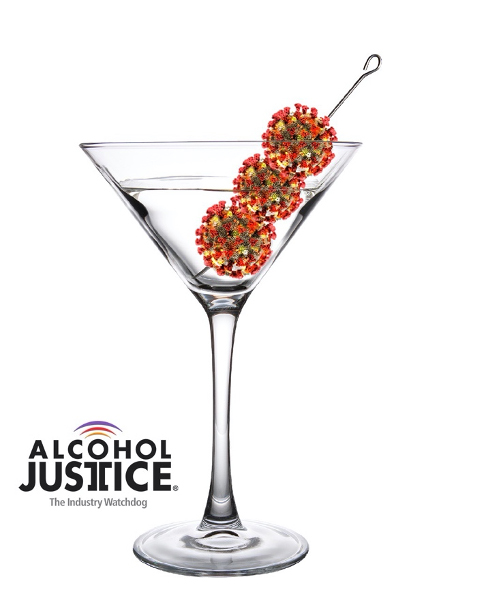
As the world still reels from the impact of the COVID-19 pandemic, researchers at the National Institutes of Alcohol Abuse and Alcoholism found an echoing disaster unfolding: a 25% increase in alcohol-related deaths between 2019 and 2020. In a research letter published in the Journal of the American Medical Assocation (JAMA), the team, headed by Aaron White, PhD, noted that though the U.S. had been experiencing a steady increase in alcohol mortality over the past 20 years, the onset of the pandemic, lockdowns, and rampant industry deregulation saw that rate increase 11-fold. In total, nearly 100,000 lives lost in 2020 wholly or partially involved alcohol.
“This is a massive blindspot in health policy coming around to bite us,” said Carson Benowitz-Fredericks, MSPH, Research Director at Alcohol Justice. “When alcohol deaths are treated as a moral failure and not a product of how alcohol is promoted and sold, then sudden trauma or upheaval can add tens of thousands to the death toll.”Warnings of this upheaval have been noted for the past decade. In 2018, a study in the British Medical Journal observed a stunning spike in alcohol-related liver disease, including a 10.5% rate of increase among 25-34 year-olds. A 2020 report from Dr. White and colleagues analyzed death certificates for alcohol-related causes and found a rate increase of 50.5% between between 1999 and 2017. (Both of White’s reports talk about a rate increase, not just simple number of deaths. Because the rates are per capita, they account for population changes—and accumulate year-over-year to staggering degree. If the 25% rate increase from 2019-2020 becomes the new norm, then the numbers of alcohol deaths in 2025 will be 3 times what they were in 2020.) But something, or some things, about the COVID-19 pandemic severely aggravated the dangers of alcohol use.
One possible answer was an overall increase in risky drinking, particularly hazardous drinking. Between the civic disruptions from lockdowns, the trauma and grief from family deaths, and the steady anxiety, U.S. residents may have leaned harder into drinking.
Multiple studies evaluating alcohol during the lockdowns observed changes in alcohol use favoring more hazardous drinking patterns. A nationwide survey published in JAMA found that alcohol consumption increased 14% overall, while a survey conducted by RTI observed a 29% increase in overall drinking, 20% increase in heavy drinking, and 21% increase in binge drinking. An Alcohol Justice/Institute for Public Strategies survey of residents of Los Angeles County found that dangerous drinking skyrocketed among individuals already prone to binge drinking.
White and colleagues tease out other interesting patterns, however. There are many reasons to believe alcohol use makes individuals more likely to die from COVID-19 infection, including diminished immune response, poorer adherence to infection-avoidant behavior, and the existing inflammation from alcohol use exacerbating the lethal lung inflammation caused by COVID. In particular, while alcohol deaths in individuals with an alcohol use disorder (AUD) rose dramatically, the number of deaths reported in individuals who had overdosed from opioids with alcohol in their system rose even more (35.1% vs. 40.8%). Alcohol and other sedatives, when mixed with opioids, make overdose much more likely. With the explosion of extremely potent fentanyl in the illegal drug supply, both in terms of injection use and counterfeit medication, mixing alcohol and opioids may have become substantially more dangerous.
All of this assumes that the increase happened in a vacuum, that there was nothing legislators and civic leaders could do as the emotional toll of the pandemic mounted. Yet White and colleagues clearly identify “shifting alcohol policies” as a contributor to this rising death rate. Indeed, California, like most states in the country, rapidly sought to deregulate the alcohol market. Between expanding the service footprint for nearly every interested alcohol licensee, encouraging and enabling app-based alcohol delivery, and encouraging alcohol consumption in nearly all public venues, drinking rapidly became normalized in all sorts of contexts in which people would not have otherwise thought to have a drink. As the nation slowly recovers from the disease (or at least, resigns itself to the ongoing infection and death), legislators, spurred on by Big Alcohol and a myopic fixation on alcohol sales to boost a damaged economy, have made these changes permanent.
“It’s hard to realize the sheer scope of harm from alcohol on demand, alcohol on the street, alcohol everywhere,” said Michael Scippa, Public Affairs Director for Alcohol Justice. “But this study is a wake-up call. An extra drink a day, 7 extra drinks a week, one extra night slamming shots—it’s easy for lawmakers to say ‘Oh, it’s not going to hurt me. It’s not gonna hurt anyone I know.'”
“But,” he added, “look at these numbers and tell me it definitely won’t hurt someone else you meet, someone else you know, someone else you love.”
READ MORE about alcohol deregulation in California during COVID-19.
READ MORE about the impacts of alcohol use on the risk of COVID-19 infection.
